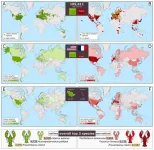(Press-News.org) Medicare could save up to 74% of the money lost from discarded Alzheimer’s drug lecanemab by the simple introduction of a new vial size that would reduce the amount of unused medication that is thrown away, new research suggests.
The researchers on the study, to be published October 14 in the peer-reviewed JAMA Internal Medicine, estimate that Medicare could waste up to $336 million annually due to discarded medication. Administered dosages are based on each patient’s body weight. But because the drug is currently available only in single-use 500 mg and 200 mg vials, substantial amounts of the expensive medication are discarded when the dose a patient is prescribed is lower than the amount contained in the vials.
Clinical trials have found that the drug, intended for people with mild cognitive impairment or mild dementia, has marginal net clinical benefit. Previous UCLA-led research has suggested that the cost of the drug, plus ancillary costs such as treatment for brain swelling linked to the medication, could cost Medicare $2 billion to $5 billion per year.
Healthcare costs continue to increase each year, placing significant strain on the Medicare budget, said lead author Frank Zhou, a fourth-year medical student at the David Geffen School of Medicine at UCLA.
“It is imperative to reduce spending on services that do not improve the health of patients, and this is a prime example of such, given that Medicare is paying for a drug only to literally throw part of it away,” he said. “There are significant opportunities for savings even with this single drug, implying that even greater savings could be achieved if our proposed solutions were applied to other infused therapies.”
Medicare spent $33 billion on Part B infusion drugs in 2021, said Dr. John Mafi, associate professor-in-residence of medicine in the division of general internal medicine and health services research at the David Geffen School of Medicine at UCLA.
“So there is substantial opportunity for cost savings by reducing waste from all infusion drugs said Mafi, the study’s senior author.
Under the Infrastructure Investment and Jobs Act of 2021, manufacturers are required to reimburse Medicare for waste exceeding 10%, Zhou said. “However, we estimate lecanemab waste to be only 5.8%, rendering current policy ineffective, and sounding the bell that further policy changes are likely needed,” he said.
Using the nationally representative 2020 Health and Retirement Study, the researchers analyzed data from participants aged 65 years and older, had Medicare Part B coverage, and were eligible for lecanemab. They calculated each person’s required weight-based dose, subtracted that amount from each patient’s dispensed dose to determine how much would be discarded, and then multiplied that amount by the number of doses per year to estimate the annual wasted amount.
For instance, a 65 kg patient would be prescribed a 650 mg dose. Given that this patient would be dispensed one 500 mg vial and a 200 mg vial, 50 mg would ultimately be tossed out.
Assuming conservative lecanemab uptake rates of 1.1-2.9% for an estimated 82,000 to 208,000 of eligible people, current vial sizes would lead to an estimated $133 million to $336 million worth of medication thrown away every year. This means that the discarded lecanemab from 16 patients could provide enough medication for an additional person. The researchers suggest that this waste could be reduced by 74% by adding a third, 75 mg vial without significantly harming quality of care or risking a drug price increase that exceeds inflation.
The cohort the researchers studied may not have identical weights to actual lecanemab users, expected uptake rates are not precise, manufacturing and regulatory costs of changing vial sizes were not incorporated into the findings, and the amount of waste may have been underestimated due to the algorithm used, all of which limit the findings, the researchers note.
Study co-authors are Chi-Hong Tseng, Mei Leng, Dr. Benjo Delarmente, Dr. Catherine Sarkisian, and Dr. John Mafi of UCLA, and Cheryl Damberg of RAND Corporation.
The study was funded by the National Institute on Aging (R01AG070017-01).
END
Smaller vial size for Alzheimer’s drug could save Medicare hundreds of millions per year
Nearly 6% of Alzheimer's drug lecanemab is discarded, costing Medicare $1,600 per patient per year
2024-10-14
ELSE PRESS RELEASES FROM THIS DATE:
Human temporal resolution of odor is shorter than thought: Study
2024-10-14
When we inhale, airborne chemicals enter our nose, creating the "odor" we detect. These chemicals are then expelled when we exhale. Each breath lasts 3–5 seconds, which seems to limit how quickly we can perceive odors. Chemical changes that occur within a single breath appear to be combined into one odor. Because of this, our sense of smell, or olfaction, is often considered a slow sense.
Now, however, researchers led by Dr. ZHOU Wen from the Institute of Psychology of the Chinese Academy of Sciences have challenged this view. Their new study, ...
Scientists discover unexpected link between genes involved in human brain evolution and developmental disorders
2024-10-14
Leuven, 14 October 2024 - The human brain’s remarkably prolonged development is unique among mammals and is thought to contribute to our advanced learning abilities. Disruptions in this process may explain certain neurodevelopmental diseases. Now, a team of researchers led by Prof. Pierre Vanderhaeghen (VIB-KU Leuven), together with scientists of Columbia University and Ecole Normale Supérieure has discovered a link between two genes, present only in human DNA, and a key gene called SYNGAP1, which is mutated in intellectual disability and autism spectrum disorders. Their study, published in Neuron, provides a surprisingly direct link between human brain ...
Ancient 3D paper art, kirigami, could shape modern wireless technology
2024-10-14
The future of wireless technology — from charging devices to boosting communication signals — relies on the antennas that transmit electromagnetic waves becoming increasingly versatile, durable and easy to manufacture. Researchers at Drexel University and the University of British Columbia believe kirigami, the ancient Japanese art of cutting and folding paper to create intricate three-dimensional designs, could provide a model for manufacturing the next generation of antennas.
Recently published in the journal Nature Communications, research from the Drexel-UBC team showed how kirigami — a variation of origami — ...
Integrating machine learning with statistical methods enhances disease risk prediction models
2024-10-14
Researchers from Peking University have conducted a comprehensive systematic review on the integration of machine learning into statistical methods for disease risk prediction models, shedding light on the potential of such integrated models in clinical diagnosis and screening practices. The study, led by Professor Feng Sun from the Department of Epidemiology and Biostatistics, School of Public Health, Peking University, has been published in Health Data Science.
Disease risk prediction is crucial for early diagnosis and effective clinical decision-making. However, traditional statistical models, such as logistic regression and Cox proportional hazards regression, often ...
Changing watering practices to improve tomato plant health
2024-10-14
Some people believe that talking to your plants makes them thrive. While there’s limited scientific support for sound improving plant health, there’s a growing amount of evidence about the benefits of mechanical stimulation, like touch, wind or rain. Researchers reporting in ACS’ Journal of Agricultural and Food Chemistry examined the impact of watering practices on tomato plants. They found that the size of the water droplets affected plant growth and resistance to pests and pathogens.
Climate change threatens crop production as rising ...
Six proteins implicated in early-onset preeclampsia
2024-10-14
Preeclampsia is a life-threatening pregnancy complication marked by persistent high blood pressure that is even more serious when it occurs early in the first trimester. The exact cause of early-onset preeclampsia is unknown, and it is difficult to predict, prevent and diagnose. Now, in ACS’ Journal of Proteome Research, researchers report on six proteins that could be used as targets to diagnose and treat the condition.
Preeclampsia’s key symptom is high maternal blood pressure, and serious cases can lead to maternal organ failure, low infant birth weight, or maternal or fetal death. ...
Researchers at The University of Texas at San Antonio reveal oversight in AI image recognition tools
2024-10-14
Artificial intelligence can help people process and comprehend large amounts of data with precision, but the modern image recognition platforms and computer vision models that are built into AI frequently overlook an important back-end feature called the alpha channel, which controls the transparency of images, according to a new study.
Researchers at The University of Texas at San Antonio (UTSA) developed a proprietary attack called AlphaDog to study how hackers can exploit this oversight. Their findings are described in a paper written by Guenevere Chen, an assistant professor in the UTSA Department of Electrical and Computer Engineering, and her former ...
World of crayfish™: A web platform for global mapping of freshwater crayfish and pathogens
2024-10-14
Freshwater crayfish, keystone species of aquatic ecosystems, are now at the center of a new tool that promises to revolutionize conservation efforts. World of Crayfish™ (WoC), a newly launched web platform, aims to provide real-time global mapping of freshwater crayfish and their pathogens, offering an invaluable resource for researchers, conservationists, and environmental stakeholders.
Published in PeerJ Life and Environment, the article, World of Crayfish™: A web platform towards real-time global mapping of freshwater crayfish and their pathogens, highlights the urgent need for accurate, up-to-date data on ...
How to make biodiversity credits work: science-based solutions for real conservation gains
2024-10-14
Biodiversity is in crisis. Human activities are driving species extinctions at unprecedented rates, but funding for conservation remains woefully inadequate. To address this gap, the concept of a Biodiversity Credit Market (BCM) has emerged, inspired by carbon credit systems that incentivize conservation and restoration efforts.
However, while the BCM holds promise, it risks falling into the same pitfalls as its carbon counterpart—especially if it fails to implement rigorous science-backed baselines, ...
Qunova becomes first to achieve ‘chemical accuracy’ on commercial quantum computers with its hardware agnostic algorithm
2024-10-14
DAEJEON, South Korea (October 14, 2024) – Qunova Computing, a developer of quantum software applications designed to bring quantum computing to the chemical, pharmaceutical and industrial engineering industries, today announces the results from a series of recent tests performed on three different NISQ era quantum computers, each with a different qubit count. In each demonstration, Qunova’s algorithm was able to produce results with accuracy below the threshold of 1.6 millihartrees required for real-world quantum chemistry applications, a level known as ‘chemical ...
LAST 30 PRESS RELEASES:
Interaction of climate change and human activity and its impact on plant diversity in Qinghai-Tibet plateau
From addressing uncertainty to national strategy: an interpretation of Professor Lim Siong Guan’s views
Clinical trials on AI language model use in digestive healthcare
Scientists improve robotic visual–inertial trajectory localization accuracy using cross-modal interaction and selection techniques
Correlation between cancer cachexia and immune-related adverse events in HCC
Human adipose tissue: a new source for functional organoids
Metro lines double as freight highways during off-peak hours, Beijing study shows
Biomedical functions and applications of nanomaterials in tumor diagnosis and treatment: perspectives from ophthalmic oncology
3D imaging unveils how passivation improves perovskite solar cell performance
Enriching framework Al sites in 8-membered rings of Cu-SSZ-39 zeolite to enhance low-temperature ammonia selective catalytic reduction performance
AI-powered RNA drug development: a new frontier in therapeutics
Decoupling the HOR enhancement on PtRu: Dynamically matching interfacial water to reaction coordinates
Sulfur isn’t poisonous when it synergistically acts with phosphine in olefins hydroformylation
URI researchers uncover molecular mechanisms behind speciation in corals
Chitin based carbon aerogel offers a cleaner way to store thermal energy
Tracing hidden sources of nitrate pollution in rapidly changing rural urban landscapes
Viruses on plastic pollution may quietly accelerate the spread of antibiotic resistance
Three UH Rainbow Babies & Children’s faculty elected to prestigious American Pediatric Society
Tunnel resilience models unveiled to aid post-earthquake recovery
Satellite communication systems: the future of 5G/6G connectivity
Space computing power networks: a new frontier for satellite technologies
Experiments advance potential of protein that makes hydrogen sulfide as a therapeutic target for Alzheimer’s disease
Examining private equity’s role in fertility care
Current Molecular Pharmacology achieves a landmark: real-time CiteScore advances to 7.2
Skeletal muscle epigenetic clocks developed using postmortem tissue from an Asian population
Estimating unemployment rates with social media data
Climate policies can backfire by eroding “green” values, study finds
Too much screen time too soon? A*STAR study links infant screen exposure to brain changes and teen anxiety
Global psychiatry mourns Professor Dan Stein, visionary who transformed mental health science across Africa and beyond
KIST develops eco-friendly palladium recovery technology to safeguard resource security
[Press-News.org] Smaller vial size for Alzheimer’s drug could save Medicare hundreds of millions per yearNearly 6% of Alzheimer's drug lecanemab is discarded, costing Medicare $1,600 per patient per year







